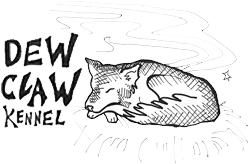“Leaders aren’t born they are made. And they are made just like anything else, through hard work. And that’s the price we’ll have to pay to achieve that goal, or any goal.”
Vince Lombardi
The leaders play a special role in the team; breaking trail, keeping pace, taking the commands that (when it all works right) allow you to drive a team through various terrains, challenges, and trail choices. So it is not surprising that people often ask us about how we pick and train our leaders. To the first part of that question there is no clear cut easy answer. How do I pick a leader? Well they kind of tell me… that dog who is always eager to go, the puppy who was always out front when you free ran, there are lots of ways a dog can show us they want to run in front of a team. So you give them a chance and see how they do. Small team leader training is the answer to the second part of that question, and it is one of the ways we test out new possible leaders and give them that chance.
Leader training is one of our favorite off season activities. By running in teams of 4-6 on the quad we have a lot of control over the dogs and can give each dog more individualized attention then is sometimes possible in a larger team. By pairing younger dogs with experienced leaders the new leaders are learning what the job is all about. It allows us to train them while at the same time they are learning from the dog right next to them.
Generally speaking leader training is any time you are working with your lead dogs. But for the purposes of this blog leader training will mean taking a small team and working through various commands with the goal of better establishing shared communication and expectations. For us leader training takes place in and around our kennel, with a trail that runs right through the middle of the dog yard and leads to a open field (or turn off to the main trail). In the open area of the field we can work on having the dogs take commands where there is no visible trail. At times there are different obstacles in the field, depending on what projects we have going on. And I have been known to park things there just to practice passing them; truck, running lawn mower, sprinkler, goats, anything that might be interesting to pass. The field is next to a burnt wooded area where we created a small maze of trails offering lots of gee/haw opportunities. There are multiple ways into the field and burn area, and we can run in, out, or through our dog yard in any direction. All this allows us to work on the commands we use in a compacted area, giving us more commands per mile then we would ever see on the trails we travel.
“Excellence is an art won by training and habituation. We do not act rightly because we have virtue or excellence, but we rather have those because we have acted rightly. We are what we repeatedly do. Excellence, then, is not an act but a habit.”
Aristotle
This leader training time is where we make sure the dogs have the right habits, and clear understandings of what the commands mean. Every dog gets a turn, not every dog wants to be a leader and it doesn’t always work out, but that’s OK. For dogs who do, it is my responsibility to teach them how to work effectively with and understand me, so they can lead a team. Even for the dogs who do not want to run in lead, leader training is valuable. In small teams every dog is hearing and reacting to commands. And we also practice skills like stay, and line out, that make a team more manageable. All of this is done early on in small groups as an investment. Establishing good behaviors before we start running larger teams makes it much easier when we do.
“People ask the difference between a leader and a boss. The leader leads, and the boss drives.”
Theodore Roosevelt
I guess from Roosevelt’s perspective that makes me a driver. And in a sense he is onto something, I am not the leader, For that I rely on the amazing dogs who rise to the occasion. As the driver it is my responsibility to see the team is always well cared for, I am the brains and decision maker, logistics, massage, catering, and the list goes on. But I am not the one out front. So it is critical that there is trust and understanding between me and the dogs who are. Ultimately that is the only way the team makes it down the trail together. And the leader training we do now is a big part of what makes that possible.
The team is in action, the leaders are preparing to take us down the trail. My knee is doing great, and the question is not if I will be strong enough, but how strong will I be. And we are still very actively seeking sponsors to join our team as we work towards Iditarod 2015. A thousand miles is a long way, and we will make it there one checkpoint at a time. Please consider helping us make that journey by becoming a checkpoint sponsor ~ learn more here. Clubs, organizations, and small businesses are also welcome as checkpoint sponsors.
Of course we welcome support at all levels, and you can donate using “Paypal” at our website, or contact us to learn more about getting involved with Dew Claw. Building a team is more then just having leaders you can trust, it is everyone working together to make great things possible, and we would love to have your help building Team Dew Claw.












